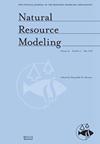Climate change and river water pollution: An application to the Ganges in Kanpur
IF 2.1
4区 环境科学与生态学
Q3 ENVIRONMENTAL SCIENCES
引用次数: 1
Abstract
We provide a theoretical framework to analyze how climate change influences the Ganges and how this influence affects pollution in the river caused by tanneries in Kanpur, India. We focus on two tanneries, A $A$ and B, $B,$ that are situated on the same bank of the Ganges in Kanpur. Both produce leather and leather production requires the use of noxious chemicals. Tannery A $A$ is situated upstream from tannery B. $B.$ Tannery A's ${A\text{'}s}$ leather production depends on labor use but tannery B's ${B\text{'}s}$ leather production depends on labor use, the chemical waste generated by tannery A, $A,$ and the natural pollution absorbing capacity of the Ganges. In this setting, we perform four tasks. First, we construct a metric that measures the climate change induced mean reduction in the natural capacity of the Ganges to absorb pollution in the time interval [0,t]. $[0,{t}].$ Second, we use this metric and determine the equilibrium production of leather by both tanneries in the benchmark case in which there is no pollution. Third, we ascertain how the benchmark equilibrium is altered when tannery B $B$ accounts for the negative externality foisted upon it by tannery A. $A.$ Finally, we study the impact on leather production and on labor use when the two tanneries merge and then discuss the policy implications stemming from our research.气候变化与河流水污染:以坎普尔恒河为例
我们提供了一个理论框架来分析气候变化如何影响恒河,以及这种影响如何影响印度坎普尔制革厂造成的河流污染。我们专注于坎普尔恒河同一河岸上的两家制革厂,A$A$和B$B$。皮革生产和皮革生产都需要使用有毒化学品。制革厂A$A$位于制革厂B$B$的上游制革厂A的${A\text{'s}$皮革生产取决于劳动力的使用,但制革厂B的$}B\text}s}美元皮革生产取决于劳动力的使用、制革厂A产生的化学废物、$A、$以及恒河的自然污染吸收能力。在此设置中,我们执行四项任务。首先,我们构建了一个指标,用于衡量气候变化导致的恒河在时间间隔[0,t]内吸收污染的自然能力的平均下降$[0,{t}].$其次,我们使用这个指标,在没有污染的基准情况下,确定两家制革厂的皮革平衡产量。第三,我们确定了当制革厂B$B$考虑到制革厂A$A$强加给它的负外部性时,基准均衡是如何改变的最后,我们研究了两家制革厂合并对皮革生产和劳动力使用的影响,然后讨论了我们的研究所产生的政策影响。
本文章由计算机程序翻译,如有差异,请以英文原文为准。
求助全文
约1分钟内获得全文
求助全文
来源期刊

Natural Resource Modeling
环境科学-环境科学
CiteScore
3.50
自引率
6.20%
发文量
28
审稿时长
>36 weeks
期刊介绍:
Natural Resource Modeling is an international journal devoted to mathematical modeling of natural resource systems. It reflects the conceptual and methodological core that is common to model building throughout disciplines including such fields as forestry, fisheries, economics and ecology. This core draws upon the analytical and methodological apparatus of mathematics, statistics, and scientific computing.
 求助内容:
求助内容: 应助结果提醒方式:
应助结果提醒方式:


